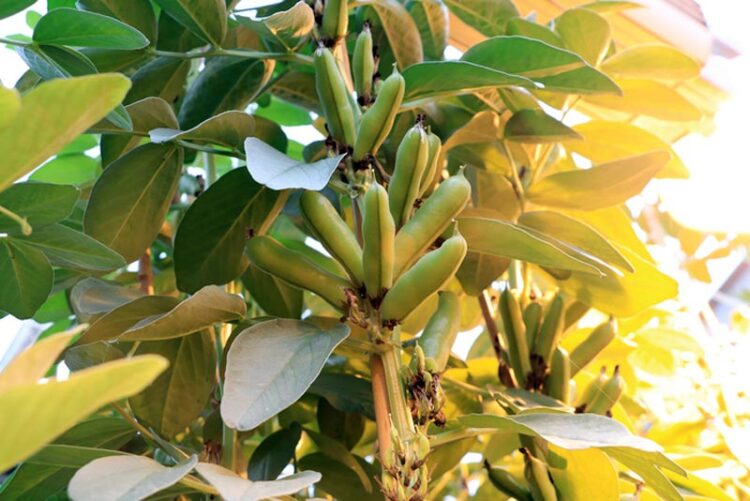The giant faba bean genome finally sequenced

Faba beans
Credit: INRAE - Sandrine Barbot
Vicia faba L., commonly referred to as “faba bean” or “broad bean”, is known for its protein-rich seeds and its yield potential in agriculture. It is used for human consumption as well as for animal feed. It also provides much needed ecosystem services in the context of the transition to more sustainable farming systems. In particular, it is able to fix atmospheric nitrogen and acquire nutrients through beneficial interactions with soil bacteria or fungi, thus reducing the need for fertilisers.
Reconstructing the genome sequence of faba bean was a challenge as it consists of 13 billion nucleobases, at least 4 times larger than the human genome. The genetic information in faba bean is carried on only 6 pairs of chromosomes. Chromosome 1 (the longest) alone is the size of the 23 chromosomes in the human genome combined.
Recent advances in sequencing techniques have made it possible to obtain a high-quality assembly despite the richness of this genome in transposable elements, highly repeated and similar DNA sequences. An imbalance in the rates of amplification and elimination of some of these repeats has in fact been identified as the cause of the expansion in the size of the faba bean genome.
Through quantitative genetic approaches and mining of genome data, the consortium has for the first time identified the genes controlling traits of interest in this legume, such as seed size.
This now available new resource opens up new research prospects, in particular by comparing legume genomes with each other. In a context of high demand for plant proteins and changes in agricultural practices, it will also facilitate varietal selection for traits related to these issues.
Journal: Nature
DOI: 10.1038/s41586-023-05791-5
Article Title: The giant diploid faba genome unlocks variation in a global protein crop
Article Publication Date: 8-Mar-2023
Media Contact
All latest news from the category: Life Sciences and Chemistry
Articles and reports from the Life Sciences and chemistry area deal with applied and basic research into modern biology, chemistry and human medicine.
Valuable information can be found on a range of life sciences fields including bacteriology, biochemistry, bionics, bioinformatics, biophysics, biotechnology, genetics, geobotany, human biology, marine biology, microbiology, molecular biology, cellular biology, zoology, bioinorganic chemistry, microchemistry and environmental chemistry.
Newest articles

NASA: Mystery of life’s handedness deepens
The mystery of why life uses molecules with specific orientations has deepened with a NASA-funded discovery that RNA — a key molecule thought to have potentially held the instructions for…

What are the effects of historic lithium mining on water quality?
Study reveals low levels of common contaminants but high levels of other elements in waters associated with an abandoned lithium mine. Lithium ore and mining waste from a historic lithium…

Quantum-inspired design boosts efficiency of heat-to-electricity conversion
Rice engineers take unconventional route to improving thermophotovoltaic systems. Researchers at Rice University have found a new way to improve a key element of thermophotovoltaic (TPV) systems, which convert heat…



